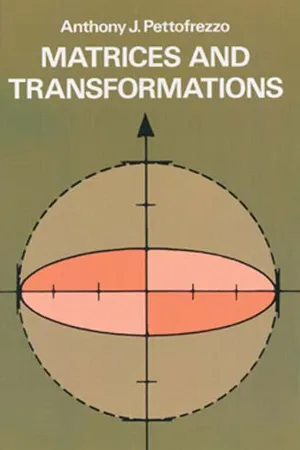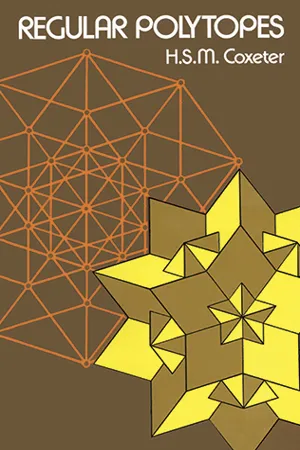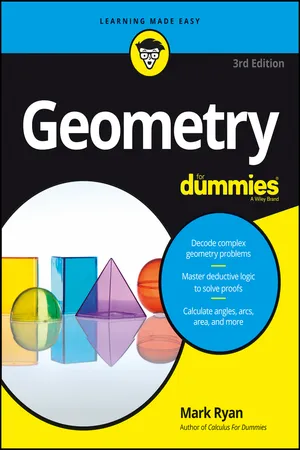Mathematics
Rotations
Rotations in mathematics refer to the transformation of a figure around a fixed point, known as the center of rotation. This transformation involves turning the figure by a certain angle in a specific direction. Rotations are commonly described using the angle of rotation and the direction, such as clockwise or counterclockwise.
Written by Perlego with AI-assistance
Related key terms
Related key terms
1 of 4
Related key terms
1 of 3
6 Key excerpts on "Rotations"
- eBook - ePub
Linear Methods
A General Education Course
- David Hecker, Stephen Andrilli(Authors)
- 2018(Publication Date)
- Chapman and Hall/CRC(Publisher)
■ Rotations Another basic geometric transformation of the plane is a rotation of the entire plane about the origin. In particular, we have: Rotation: Multiplying by the matrix [ cos θ − sin θ sin θ cos θ ] performs a counterclockwise rotation of the plane about the origin through an angle with measure θ. To perform a clockwise rotation of the plane through the origin with measure θ, we can perform a counterclockwise rotation of the plane about the origin through an angle with measure (− θ) instead. Such a transformation involves multiplying by the matrix [ cos (− θ) − sin (− θ) sin (− θ) cos (− θ) ] = [ cos θ sin θ − sin θ cos θ ]. Notice that the matrix for a clockwise rotation through angle θ is the transpose of the matrix for the corresponding counterclockwise rotation through the angle θ. Example 4. For θ = 30°, since cos 30 ο = 3 2 and sin 30 ο = 1 2, the. matrix [ 3 2 − 1 2 1 2 3 2 ] performs a counterclockwise rotation about the origin through an angle of 30°. We illustrate this in Figure 7.2 by showing the image of a four-sided polygon (quadrilateral) using this transformation. The four vertices of the quadrilateral are (4, 1), (5, 4), (6, 3), and (6, 0). Hence the images of these vertices are computed as follows: [ 3 2 − 1 2 1 2 3 2 ] [ 4 5 6 6 1 4 3 0 ] = [ 3.0 2.3 3.7 5.2 2.9 6.0 5.6 3.0 ], Figure 7.2: Counterclockwise 30° Rotation of a Quadrilateral rounded to one place after the decimal point. This produces the following four vertices for the image of the quadrilateral: (3.0, 2.9), (2.3, 6.0), (3.7, 5.6), and (5.2, 3.0). ■ Reflections Another important basic geometric transformation of the plane is a reflection about a line through the origin. For such a reflection, the image of each point in the plane is on the opposite side of the line of reflection, the segment connecting a point and its image is perpendicular to the line of reflection, and that segment has its midpoint on the line of reflection - eBook - ePub
Linear Algebra
An Inquiry-Based Approach
- Jeff Suzuki(Author)
- 2021(Publication Date)
- CRC Press(Publisher)
3Transformations
3.1 Geometric Transformations
An important concept in mathematics is that of a transformation, where we take some object and alter it to produce a new object. The most familiar type of transformation is a geometric transformation. We can look at these transformations in two ways:- Geometrically: We reflect a point across an axis, or rotate it about a center of rotation, or translate it some distance horizontally and vertically,
- Algebraically: We take the coordinates of the point( x , y )and alter them to produce a new set of coordinates for the point(.x ′,y ′)
In either case, we say that the new point is the image of the original under the transformation. Additionally, we might say the original point is the preimage of the transformed point.One way to view the transformation is as a set of functions, where the new coordinates(are functions of the old coordinates,x ′,y ′)x ′= f ( x , y )y ′= g ( x , y )wheref ( x , y )andg ( x , y )are some formulas that involve x and y.Example 3.1. Consider a translation that shifts every point 3 units to the right. Express the new coordinates(in terms of the old coordinatesx ′,y ′)( x , y ).Solution. Let’s draw a picture showing how a generic point with coordinates( x , y )is affected by this translation:Since the point has been shifted 3 units to the right, the new x-coordinate must be 3 more than the original:x ′= x + 3But since the point has not been shifted up or down, the new y-coordinate is the same as the original:y ′= yActivity 3.1: Geometric TransformationsA3.1.1 For each transformation given, find formulas that compute the new coordinates(from the original coordinatex ′,y ′)( x , y ).- Mx, the reflection of a point across the x
- eBook - ePub
- Anthony J. Pettofrezzo(Author)
- 2012(Publication Date)
- Dover Publications(Publisher)
H of linear homogeneous transformations.Figure 3-15The set of ordered products of the rigid motion transformations of the plane may be represented by a matrix of the form where(3-20)Furthermore,(3-21)and(3-22)Two theorems which state that a general linear transformation of the plane is a rigid motion transformation if and only if the matrix representing the transformation satisfies conditions (3-21) and (3-22) will be proved now.Theorem 3-3 Letrepresent a general linear transformation of the plane under which distance is a scalar invariant. Thenanda 11 a 12 + a 21 a 22 = 0.Proof : Consider the points O : (0, 0, 1) and P : (1, 0, 1). Under the transformation represented by T , the image points of O and P are O′: (a 13 , a 23 , 1) and P ’: (a 11 + a 13 , a21 , + a 23 , 1), respectively. Since under the transformation represented by T ,In a similar manner, choosing O : (0, 0, 1) and P : (0, 1, 1), it can be shown thatNow, consider the points O : (0, 0, 1) and P : (1, 1, 1). Under the transformation represented by T , the image points of O and P are O′: (a 13 , a 23 , 1) and P ’: (a 11 + a 12 + a 13 , a 21 + a 22 + a 23 , 1), respectively. Again, since under the transformation represented by T ,Theorem 3-4 Letrepresent a general linear transformation of the plane such that , , and a 11 a 12 + a 21 a 22 = 0. Then distance is a scalar invariant under the transformation represented by T.Proof : Consider any two points P 1 : (x 1 , y 1 , 1) and P 2 : (x 2 , y 2 , 1) on the plane. Under the transformation represented by T, the image points of P 1 and P 2 are (a 11 x 1 + a 12 y 1 + a 13 , a 21 x 1 + a 22 y 1 . + a 23 , 1) and (a 11 x 2 + a 12 y 2 + a 13 , a 21 x 2 + a 22 y 2 + a 23 - eBook - ePub
- H. S. M. Coxeter(Author)
- 2012(Publication Date)
- Dover Publications(Publisher)
QO ), i.e., a screw-displacement. Hence3.14. Every displacement is a screw -displacement (including, in particular, a rotation or a translation).423.2. Transformations in general. The concept of a congruent transformation, applied to figures in space, can be generalized to that of a one-to-one transformation applied to any set of elements. 43 When we speak of the resultant of two transformations as their “ product ”, we are making use of the analogy that exists between transformations and numbers. We shall often use letters R, S, ... to denote transformations, and write RS for the resultant of R and S (in that order). This notation is justified by the validity of the associative law3·21Since a number is unchanged when multiplied by 1, it is natural to use the same symbol 1 for the “ identical transformation ” or identity (which enters our discussion as the translation through no distance, and again as the rotation through angle 0 or through a complete turn). Pushing the analogy farther, we let Rp denote the p -fold application of R ; e.g., if R is a rotation through θ , Rp is the rotation through p θ about the same axis. A transformation R is said to be periodic if there is a positive integer p such that Rp =1; then its period is the smallest p for which this happens. We also let R−1 denote the inverse of R, which neutralizes the effect of R, so that RR−1 = 1 = R−1 R. If R is of period p , we have R−1 =Rp - eBook - ePub
- Mark Ryan(Author)
- 2016(Publication Date)
- For Dummies(Publisher)
The amount of turning is called the rotation angle. In this section, you see that a rotation, just like a translation, is the equivalent of two reflections. Then you find out how to find the center of rotation. A rotation equals two reflections You can achieve a rotation with two reflections. The way this works is a bit tricky to explain (and the mumbo-jumbo in the following theorem might not help much), so check out Figure 19-6 to get a better handle on this idea. © John Wiley & Sons, Inc. FIGURE 19-6: Two reflections make a rotation. A rotation equals two reflections: A rotation is equivalent to two reflections over lines that Pass through the center of rotation Form an angle half the measure of the rotation angle In Figure 19-6, you can see that pre-image has been rotated counterclockwise to image. This rotation can be produced by first reflecting over line l 1 and then reflecting it again over l 2. The angle formed by l 1 and l 2,, is half of the angle of rotation. Finding the center of rotation and the equations of two reflecting lines Just as in the previous section on translations, the easiest way to understand the rotation theorem is by doing a problem: In the following figure, pre-image triangle has been rotated to create image triangle. © John Wiley & Sons, Inc. Find the center of rotation. I have a nifty method for locating the center of rotation. Here’s how it works. Take the three segments that connect pre-image points to their image points (in this case,,, and). In all Rotations, the center of rotation lies at the intersection of the perpendicular bisectors of such segments (it’d get too involved to explain why, so just take my word for it). Because the three perpendicular bisectors meet at the same point, you need only two of them to find the point of intersection - eBook - ePub
- Fletcher Dunn, Ian Parberry(Authors)
- 2011(Publication Date)
- A K Peters/CRC Press(Publisher)
Section 2.4.1 discussed that it’s impossible to describe the position of an object in absolute terms—we must always do so within the context of a specific reference frame. When we investigated the relationship between “points” and “vectors,” we noticed that specifying a position is actually the same as specifying an amount of translation from some other given reference point (usually the origin of some coordinate system).In the same way, orientation cannot be described in absolute terms. Just as a position is given by a translation from some known point, an orientation is given by a rotation from some known reference orientation (often called the “identity” or “home” orientation). The amount of rotation is known as an angular displacement . In other words, describing an orientation is mathematically equivalent to describing an angular displacement.We say “mathematically equivalent” because in this book, we make a subtle distinction between “orientation” and terms such as “angular displacement” and “rotation.” It is helpful to think of an “angular displacement” as an operator that accepts an input and produces an output. A particular direction of transformation is implied; for example, the angular displacement from the old orientation to the new orientation, or from upright space to object space. An example of an angular displacement is, “Rotate 90º about the z -axis.” It’s an action that we can perform on a vector.However, we frequently encounter state variables and other situations in which this operator framework of input/output is not helpful and a parent/child relationship is more natural. We tend to use the word “orientation” in those situations. An example of an orientation is, “Standing upright and facing east.” It describes a state of affairs.
Index pages curate the most relevant extracts from our library of academic textbooks. They’ve been created using an in-house natural language model (NLM), each adding context and meaning to key research topics.
Explore more topic indexes
Explore more topic indexes
1 of 6
Explore more topic indexes
1 of 4





